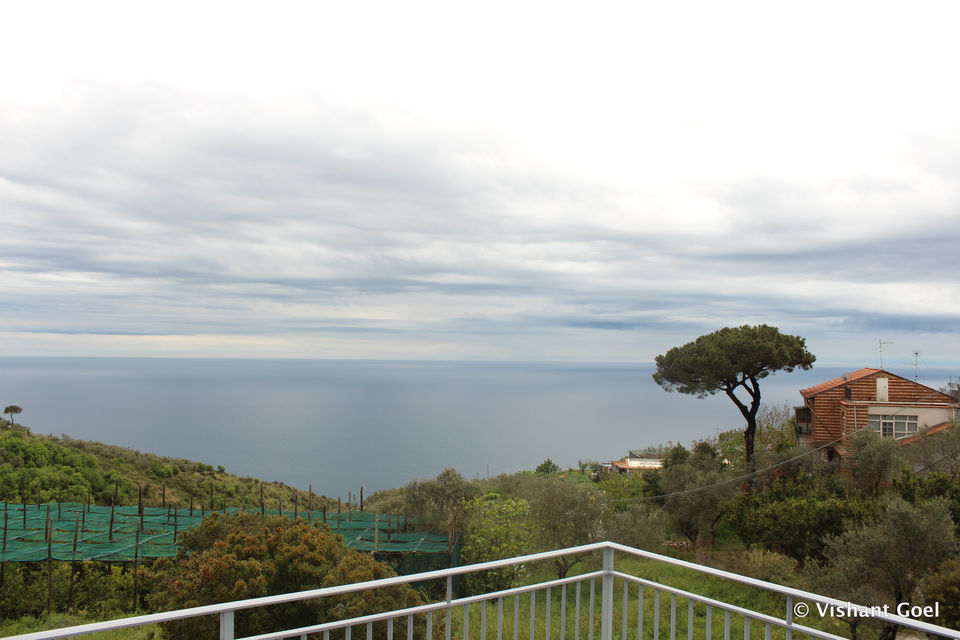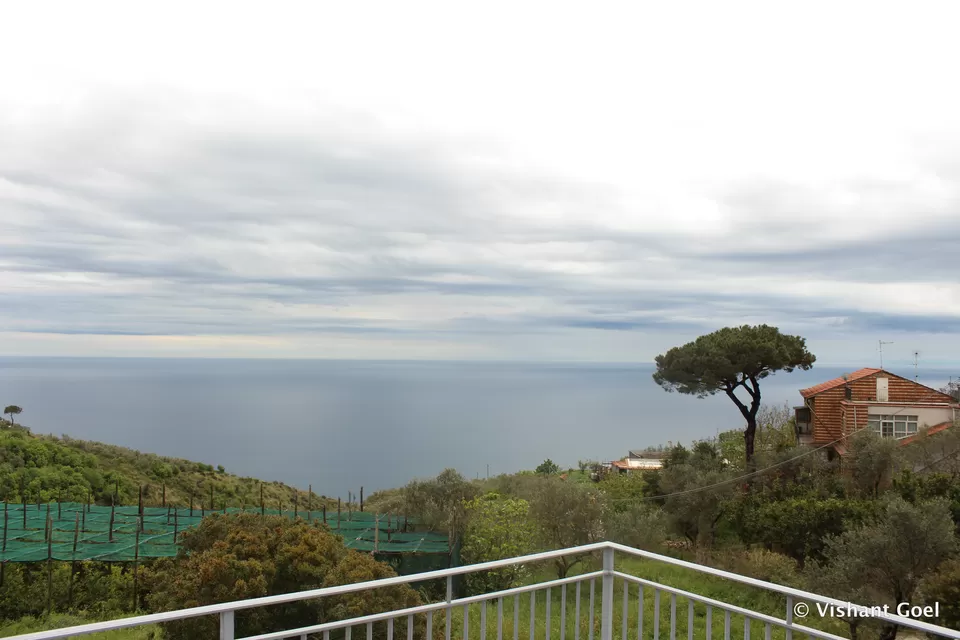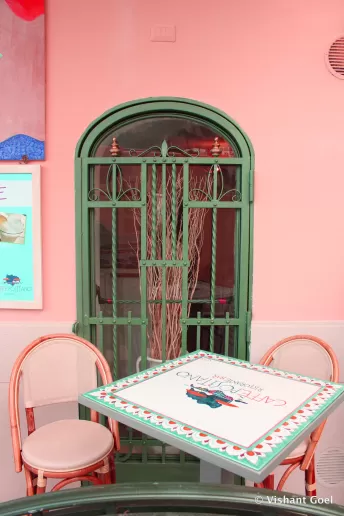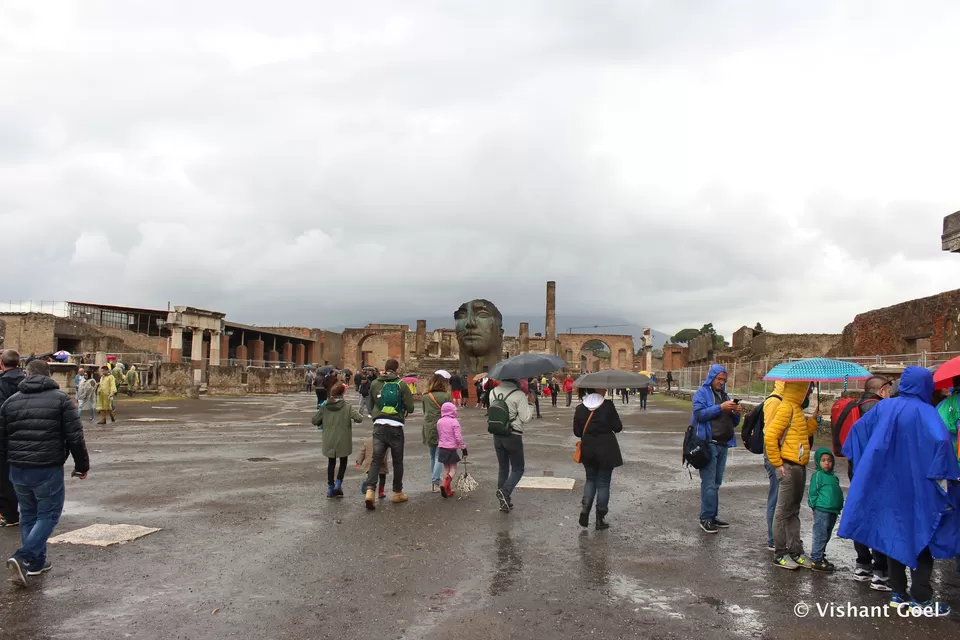
We left Rome early in the morning, departing on a train to Naples. The journey took 2 hours during which we passed a variety of landscape and reached our destination a little past 8 AM. From Naples we boarded a local train which made up a quite interesting ride to Sorrento. This is the train which locals use for commuting along the coastal towns of southern Italy and has very striking characteristics. The first striking characteristic that you come across is the graffiti on the outside. As soon as you board, you'll find yourself in the company of street musicians playing Accordion and singing in Italian.
Upon reaching Sorrento, we called our host, Gaitano from casa colarusso, Masa Lubrense - a quiet town on the coast. It started to rain heavily but luckily our host picked us up in his car and took us to our cozy accommodations.
At the first look of our rooms, we were left astounded by the beauty of the view from our balcony. It was the most beautiful scene I had ever seen. Calm Mediterranean sea covered by dark clouds. The room was very well equipped with modern amenities. Gaitano and his wife ran the establishment quite efficiently.

To experience Amalfi coast at its best, you need nothing more than a free spirit and a casual summer afternoon. The former is required so that you have a rich and fulfilling experience of southern Italian culture and not barely scratch the surface on one of the most beautiful coastal strip in the world. The dwindling Amalfi drive provides most breathtaking views of the Tyrrhenian Sea but there is more to Amalfi than its awe-inspiring natural beauty.
On the path along the coast lies Positano- a quiet town which will not only leave you speechless but can also put an irreparable dent in your psyche. In fact, the town has been inspiration for many painters, writers and musicians. I have observed that every place has its unique voice through which it communicates to its visitors. Some places talk through their history, some through their culture and some through their spirit of life. Positano talks through its colors which is the first thing you notice when you get the first glance at the town.
The legend says that Positano got its name from a pirate who was carrying a stolen Byzantine painting of Virgin Mary on his ship. A terrible storm blew up in Mediterranean and the frightened sailor heard a voice saying 'Posa, Posa!' which means "Put down, Put down". The crew threw the painting into the sea and the storm subsided. The place where it washed off on the shore came to be known as Positano. The villagers built a church at the centre taking the episode a sign that the Virgin had chosen their town as resting place.
How much of this tale holds its ground is hard to tell but the church in question is very much in existence and features a thirteenth-century Byzantine icon of Madonna
Positano was built by rich romans as a leisure town for their sumptuous villas. Today, Amalfi is the destination for many Italian tourists looking for a weekend getaway. If you prefer a bit a quiet and calm, I would recommend you visit on weekdays. One of the best things to do in Amalfi is nothing. Just walk along the coast of towns like Positano and try to bask in all of its charms.

Positano is a vertical town hanging from the cliffs on the coast and can be traversed on foot via steep flights of steps or sloppy, curvy paths. The beautiful villas on the slopes of the cliff form a dramatic vertical panorama of colors which when combine with the blue of the sea form a vibrant view.
For the shopping fanatics, there are various boutiques which offer a wide variety of fashion products. Restaurants in the town serve excellent pasta but open quite late in the evening. While walking down the slopes of Positano, you'll find many wine and cheese shops but if you are looking to get a bit tipsy and keen on acquiring local authentic taste, Limoncello would be a fine choice. Its a lemon liqueur produced mainly in this region of southern Italy.
In the earlier part of 20 th century, Positano was a retreat for intellectuals, artists and celebrities. Picasso, Escher and Liz Taylor are a few of those great artists who have fallen for the town's beauty. The trend continues till date and town receives its fair share of attraction from celebrities. But one doesn't have to be a celebrity or rich to enjoy beaches of Positano.
As I mentioned, all you need a free spirit and some fine summer breeze to get yourself going.
Places
The church of Santa Maria Assunta, Spiaggia Grande beach
How to reach
Positano can be reached by the SS163 Amalfitana national road, or by the SP425 provincial road. Bus service runs from Sorrento with a frequency of half hour. Nearest airports are in Salerno and Naples.
Next day we decided to visit the ruins of Pompeii. We left early for station at Sorrento and took train towards Naples. Station of Pompeii was in middle of the railway line that ran between Naples and Sorrento.

When we reached Pompeii it started drizzling but our spirits were up seeing the crowd that queued outside the ticket window. Upon entering the complex it seemed as if we had stepped back in time. From grand statues to common household items, everything on display creates an image of a ghostly town that once flourished.
Pompeii was founded sometime during 7th century BC. Before becoming a Roman colony, it was ruled by greeks. In 45 AD, the city witnessed a massive earthquake which caused a lot of damage and evacuation of most of population. When mount Vesuvius erupted after 17 years, much of city's population still hadn't returned. Nevertheless the volcano caused the death of 20,000 men, women and children.


